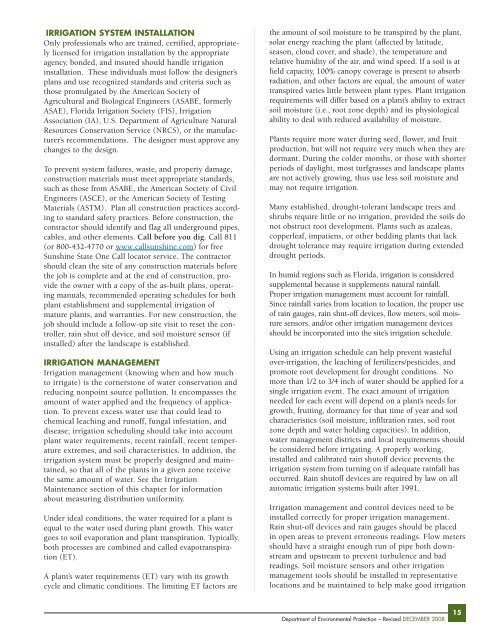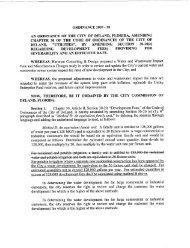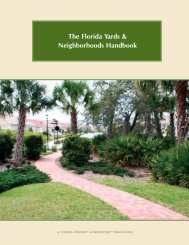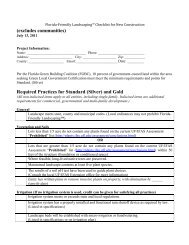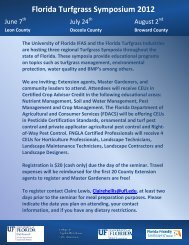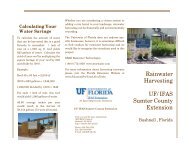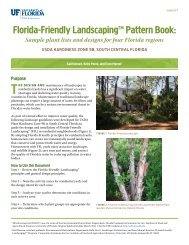Green Industries Best Management Practices manual
Green Industries Best Management Practices manual
Green Industries Best Management Practices manual
You also want an ePaper? Increase the reach of your titles
YUMPU automatically turns print PDFs into web optimized ePapers that Google loves.
IRRIGATION SYSTEM INSTALLATIONOnly professionals who are trained, certified, appropriatelylicensed for irrigation installation by the appropriateagency, bonded, and insured should handle irrigationinstallation. These individuals must follow the designer’splans and use recognized standards and criteria such asthose promulgated by the American Society ofAgricultural and Biological Engineers (ASABE, formerlyASAE), Florida Irrigation Society (FIS), IrrigationAssociation (IA), U.S. Department of Agriculture NaturalResources Conservation Service (NRCS), or the manufacturer’srecommendations. The designer must approve anychanges to the design.To prevent system failures, waste, and property damage,construction materials must meet appropriate standards,such as those from ASABE, the American Society of CivilEngineers (ASCE), or the American Society of TestingMaterials (ASTM). Plan all construction practices accordingto standard safety practices. Before construction, thecontractor should identify and flag all underground pipes,cables, and other elements. Call before you dig. Call 811(or 800-432-4770 or www.callsunshine.com) for freeSunshine State One Call locator service. The contractorshould clean the site of any construction materials beforethe job is complete and at the end of construction, providethe owner with a copy of the as-built plans, operating<strong>manual</strong>s, recommended operating schedules for bothplant establishment and supplemental irrigation ofmature plants, and warranties. For new construction, thejob should include a follow-up site visit to reset the controller,rain shut off device, and soil moisture sensor (ifinstalled) after the landscape is established.IRRIGATION MANAGEMENTIrrigation management (knowing when and how muchto irrigate) is the cornerstone of water conservation andreducing nonpoint source pollution. It encompasses theamount of water applied and the frequency of application.To prevent excess water use that could lead tochemical leaching and runoff, fungal infestation, anddisease; irrigation scheduling should take into accountplant water requirements, recent rainfall, recent temperatureextremes, and soil characteristics. In addition, theirrigation system must be properly designed and maintained,so that all of the plants in a given zone receivethe same amount of water. See the IrrigationMaintenance section of this chapter for informationabout measuring distribution uniformity.Under ideal conditions, the water required for a plant isequal to the water used during plant growth. This watergoes to soil evaporation and plant transpiration. Typically,both processes are combined and called evapotranspiration(ET).A plant’s water requirements (ET) vary with its growthcycle and climatic conditions. The limiting ET factors arethe amount of soil moisture to be transpired by the plant,solar energy reaching the plant (affected by latitude,season, cloud cover, and shade), the temperature andrelative humidity of the air, and wind speed. If a soil is atfield capacity, 100% canopy coverage is present to absorbradiation, and other factors are equal, the amount of watertranspired varies little between plant types. Plant irrigationrequirements will differ based on a plant’s ability to extractsoil moisture (i.e., root zone depth) and its physiologicalability to deal with reduced availability of moisture.Plants require more water during seed, flower, and fruitproduction, but will not require very much when they aredormant. During the colder months, or those with shorterperiods of daylight, most turfgrasses and landscape plantsare not actively growing, thus use less soil moisture andmay not require irrigation.Many established, drought-tolerant landscape trees andshrubs require little or no irrigation, provided the soils donot obstruct root development. Plants such as azaleas,copperleaf, impatiens, or other bedding plants that lackdrought tolerance may require irrigation during extendeddrought periods.In humid regions such as Florida, irrigation is consideredsupplemental because it supplements natural rainfall.Proper irrigation management must account for rainfall.Since rainfall varies from location to location, the proper useof rain gauges, rain shut-off devices, flow meters, soil moisturesensors, and/or other irrigation management devicesshould be incorporated into the site’s irrigation schedule.Using an irrigation schedule can help prevent wastefulover-irrigation, the leaching of fertilizers/pesticides, andpromote root development for drought conditions. Nomore than 1/2 to 3/4 inch of water should be applied for asingle irrigation event. The exact amount of irrigationneeded for each event will depend on a plant’s needs forgrowth, fruiting, dormancy for that time of year and soilcharacteristics (soil moisture, infiltration rates, soil rootzone depth and water holding capacities). In addition,water management districts and local requirements shouldbe considered before irrigating. A properly working,installed and calibrated rain shutoff device prevents theirrigation system from turning on if adequate rainfall hasoccurred. Rain shutoff devices are required by law on allautomatic irrigation systems built after 1991.Irrigation management and control devices need to beinstalled correctly for proper irrigation management.Rain shut-off devices and rain gauges should be placedin open areas to prevent erroneous readings. Flow metersshould have a straight enough run of pipe both downstreamand upstream to prevent turbulence and badreadings. Soil moisture sensors and other irrigationmanagement tools should be installed in representativelocations and be maintained to help make good irrigationDepartment of Environmental Protection – Revised DECEMBER 200815


